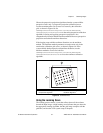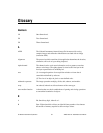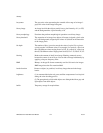
Chapter 6 Calibrating Images
© National Instruments Corporation 6-9 IMAQ Vision for Visual Basic User Manual
Calibration Invalidation
Any image processing operation that changes the image size or orientation
voids the calibration information in a calibrated image. Examples
of methods that void calibration information include
CWIMAQVision.Resample2, CWIMAQVision.Extract2,
CWIMAQVision.Unwrap, and CWIMAQImage.ArrayToImage.
Simple Calibration
When the axis of the camera is perpendicular to the image plane and lens
distortion is negligible, use simple calibration. In simple calibration, a pixel
coordinate is transformed into a real-world coordinate through scaling in
the horizontal and vertical directions.
Use simple calibration to map pixel coordinates to real-world coordinates
directly without a calibration grid. The software rotates and scales a pixel
coordinate according to predefined coordinate reference and scaling
factors. You can assign the calibration to an arbitrary image using
CWIMAQVision.SetSimpleCalibration.
To perform a simple calibration, set a coordinate system (angle, center,
and axis direction) and scaling factors on the defined axis, as shown in
Figure 6-7. Express the angle between the x-axis and the horizontal axis
of the image in degrees. Express the center as the position, in pixels, where
you want the coordinate system origin. Set the axis direction to direct or
indirect. Simple calibration also offers a correction table option and a
scaling mode option.
Use
CWIMAQSimpleCalibrationOptions.CalibrationAxisInfo
to define the coordinate reference. Use
CWIMAQSimpleCalibrationOptions.GridDescriptor
to specify the scaling factors. Use
CWIMAQSimpleCalibrationOptions.CorrectionScalingMode
to set the scaling mode. Set
CWIMAQSimpleCalibrationOptions.LearnCorrectionTable
to
True to learn the correction table.


















